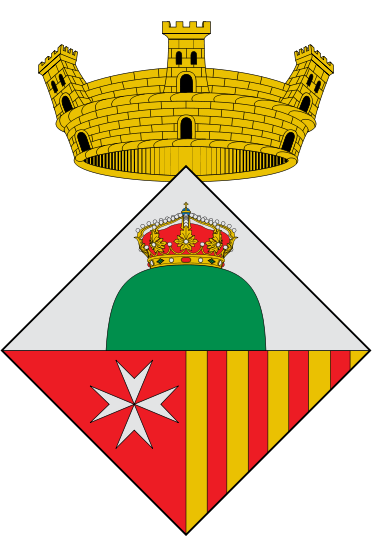Puig-reig: Difference between revisions
Knorrepoes (talk | contribs) No edit summary |
Knorrepoes (talk | contribs) m (Text replace - "[[Literature" to "{{media}} [[Literature") |
||
| Line 19: | Line 19: | ||
The arms are canting: they show a mount with a royal crown, an allusion to the etymology of the village, meaning "royal hill". Puig-reig was the centre of a Templar command (1187-1312); later the command passed to the Order of St. John of Jerusalem, until 1805; this is reflected on the arms by the Cross of Malta. Finally, the arms of Catalonia-Aragon (four pales Gules on Or) allude to the royal jurisdiction over the village, that originally belonged to the viscounts of Berga, and later to the counts of Barcelona. | The arms are canting: they show a mount with a royal crown, an allusion to the etymology of the village, meaning "royal hill". Puig-reig was the centre of a Templar command (1187-1312); later the command passed to the Order of St. John of Jerusalem, until 1805; this is reflected on the arms by the Cross of Malta. Finally, the arms of Catalonia-Aragon (four pales Gules on Or) allude to the royal jurisdiction over the village, that originally belonged to the viscounts of Berga, and later to the counts of Barcelona. | ||
{{media}} | |||
[[Literature]] : Image taken from http://escuts.wikispaces.com; background by Enric Fontvila | [[Literature]] : Image taken from http://escuts.wikispaces.com; background by Enric Fontvila | ||
Revision as of 03:56, 9 July 2014
| Heraldry of the World Civic heraldry of Spain - Heraldica Española |
PUIG-REIG
Region : Catalonia
Province : Barcelona
Official blazon
Escut caironat truncat i semipartit: 1r. d'argent, un mont de sinople movent de la punta somat d'una corona reial d'or; 2n. de gules, una creu de Malta (d'argent); i al tercer, d'or, 4 pals de gules. Per timbre una corona mural de poble.
Origin/meaning
These arms have been officially granted on 7th July 1987.
The arms are canting: they show a mount with a royal crown, an allusion to the etymology of the village, meaning "royal hill". Puig-reig was the centre of a Templar command (1187-1312); later the command passed to the Order of St. John of Jerusalem, until 1805; this is reflected on the arms by the Cross of Malta. Finally, the arms of Catalonia-Aragon (four pales Gules on Or) allude to the royal jurisdiction over the village, that originally belonged to the viscounts of Berga, and later to the counts of Barcelona.
Contact and Support
Partners:
Your logo here ?
Contact us
© since 1995, Heraldry of the World, Ralf Hartemink 
Index of the site
Literature : Image taken from http://escuts.wikispaces.com; background by Enric Fontvila











